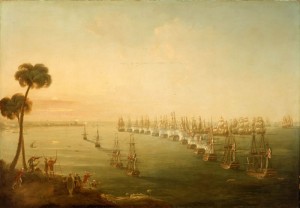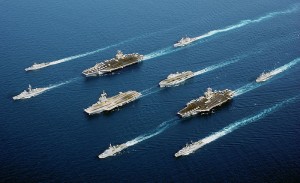
The concept of Sea-based Nations, which won a recent CIMSEC poll directing our coverage for this week, is an idea with a significant potential to impact human societies. The extent of the changes depends on how far into the utopian imagination this idea is realized. In its simplest form, Sea-based nations could describe the venture of existing states into the open oceans. If so, tensions could rise significantly as the scramble for maritime territory takes on new dimensions, but there would be little new in terms of basic rules of naval strategy. Alternately, there could be a revival of ancient Greece-like city-states, as the name “Sea-based Nations” suggests. In this case the changes to the world and its citizens would be substantial, but even here we would still operating with known concepts. The most dramatic impacts would arise from the realization of the idea of Jules Verne in 20,000 Leagues Under the Sea. In his 19th-century story, Captain Nemo and his crew of the Nautilus wanted to isolate themselves from the existing world. They cut all links and created a self-sufficient small community.
The latter two propositions could not be achieved without influencing existing maritime, and more narrowly, naval matters. The constabulary, diplomatic, and military functions of the world’s navies will be affected. And, in the most radical version – the Captain Nemo scenario – Sea-based Nations could undermine world order not by hostile actions or intentions, but simply by their existence. The bitterness in the words of Captain Nemo towards a frigate sailor in the U.S. Navy (who thought he’d been chasing a sea monster) reveal the challenges of renegade, roving, and unlocated Sea-bases facing humanity:
“M. Aronnax,” he replied, “dare you affirm that your frigate would not as soon pursued and cannonaded a submarine boat as a monster?”
From a professional standpoint, looking at the pictures of huge semi-floating structures, it is easy to imagine that military tactics will be affected as well. Let us think for a while about naval assault on such structure. Here naval warfare meets urban warfare. This raises questions not only about technology, but also about naval theory and its divergence or convergence with land warfare. Sir Julian Corbett believed that there are three principles of land warfare and that naval warfare significantly differs from them. The first principle is concentration of force and overthrowing the enemy, which is exemplified in maxim “The primary object of our battle-fleet is to seek out and destroy that of the enemy.” Here, naval warfare diverges with its concept of “fleet-in-being”:
In naval warfare we have a far-reaching fact which is entirely unknown on land. It is simply this–that it is possible for your enemy to remove his fleet from the board altogether.
The second principle is the definite lines of operation and of communications often determined by road and obstacles:
But afloat neither roads nor obstacles exist. There is nothing of the kind on the face of the sea to assist us in locating him and determining his movements.
The last principle is the concentration of efforts, which means a focus on an enemy’s force “without regard to ulterior objects.” In the case of naval warfare there is an ever-present question of lines of communication, independent from the focus on enemy forces, formulated in a simple and elegant way by Sir Julian:
Now, if we exclude fishery rights, which are irrelevant to the present matter, the only right we or our enemy can have on the sea is the right of passage;
Depending on whether the Sea-based Nation is more like Sparta than Athens, the above differences might be modified, if not eliminated. The “Fleet-in-being” strategy works only because the fleet removed from the board represents a reserve potential of action. The way of dealing with it is blockade. But what happens if a blockade is perfect?

On the other hand, as anti-access (A2) technologies matured throughout history, the close blockade became more and more costly. It was also exhausting and turned into the distant blockade. If a Sea-based Nation is a Sparta, self-sufficient in the long-term and powerful enough to push out its blockade through A2 technology, then a “fleet-in-being” would lose its importance and the difference between naval and land warfare starts to pale. Similarly, even tens or more floating Spartas will not change the sheer size of the ocean, but if located in one specific region, then they could act to increase or decrease the probable usage of particular sea routes.
The last difference would be least affected. However, some convergence comes from developments in land warfare as well. Looking at Afghanistan war, I suppose that Army generals would support Sir Julian Corbett’s focus on keeping safe lines of communications, regardless of the goal of overthrowing enemy forces.
In the end, what is the difference between armed floating cities and warships that justifies the digressions from known theories? Sustainment and self-sufficiency. If technology allows these structures enough of the two, we could face a hybrid of warships crossed with the type of well-defended islands seen in the Pacific campaign during WWII. The convergence between naval and land warfare would then accelerate.
Przemek Krajewski alias Viribus Unitis is a blogger In Poland. His area of interest is broad context of purpose and structure of Navy and promoting discussions on these subjects In his country




